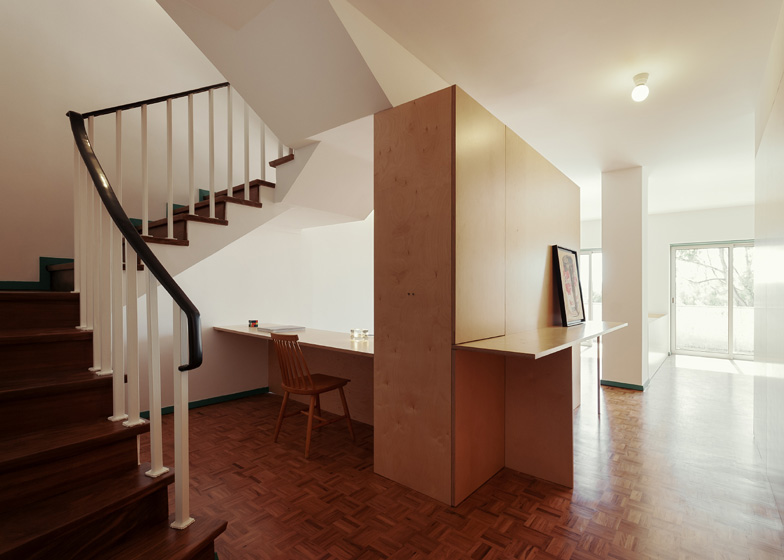Portuguese architect João Branco has converted a small office building in Coimbra into a home by installing softwood joinery that functions as furniture, storage and partitions (+ slideshow).
Described by Branco as being "closer to carpentry than building construction", the project involved adding three sections of woodwork to the lower floor of the two-storey property to create a living room, dining area, study, kitchen and toilet.
"The intervention proposes to let the light flow, converting it into a diaphanous space and thus increasing the feeling of spaciousness," said the architect.
The first wooden structure sits just beyond the entrance. It creates a study area for two people beneath the staircase, but also accommodates a cloakroom, a shelf and a gridded bookshelf.
Ahead of this, a low and narrow timber piece doubles as both a sideboard and a bench, separating the living and dining areas.
The kitchen and toilet are both housed within the third structure. This is made up of floor-to-ceiling partitions, some of which turn out to be doors, and also includes a row of kitchen cupboards and a countertop.
"The objects are designed to provide the greatest possible sobriety, resulting in a high degree of abstraction and giving the house enhanced spatial clarity," added Branco.
The original Mecrusse wood parquet floor runs throughout the space, while an existing staircase with wooden treads leads up to bedroom spaces on the level above.
Photography is by Do Mal o Menos.
Here's a project description from João Branco:
Apartment in Coimbra
Three pieces of furniture create a home. The aim was to convert a former two-floor office into a rental apartment. The proposal, which develops at the lower level, focuses on reconverting a small area, originally subdivided and dark, to accommodate the social areas of the house.
The intervention proposes to let the light flow, converting it into a diaphanous space and thus increasing the feeling of spaciousness. The main decision is not to build, intervening by dispensing with traditional construction work, in favour of a dry approach, much simpler, without creating new walls or divisions. To that, the plant is emptied, introducing in the diaphanous space three wooden pieces of furniture that will organise the space.
Firstly, a box contains wet areas: kitchen and bathroom. A mobile with a bookcase and table gives form to the the entrance and to a small office under the stairs. Finally, a movable lower furniture separates the living and eating areas. With only these three pieces, shape is given to the spaces of the house, always visually connected to maintain unity and flow of southern light.
This work, closer to carpentry than building construction, focuses on the details and encounters. Reducing to a minimum the elements, fittings, switches, etc. the objects are designed to provide the greatest possible sobriety, resulting in a high degree of abstraction and giving the house enhanced spatial clarity.



